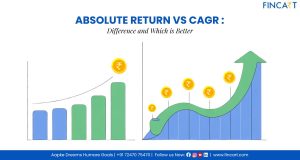Table of Contents
ToggleJust like every stock has a price, a mutual fund has an NAV that tells you about the value of its assets on a per-unit basis. NAV determines the price at which mutual fund units are bought or sold, and it gives you a picture of your investment’s current worth. So what is the meaning of NAV in mutual fund, how is it calculated, and what role does it play in gauging the performance of a fund? Let’s understand the concept of net asset value in mutual funds in detail.
What is NAV in Mutual Funds?
Let’s first define NAV in mutual funds. NAV stands for Net Asset Value, which is the value per unit of the net assets of a mutual fund. It is calculated by subtracting the fund’s total liabilities from its total assets and then dividing this by the total number of outstanding units. The number we get represents the per-unit price at which investors can buy mutual fund units or sell them.
To make things more simple, the meaning of NAV in mutual fund can be understood as the price of a single unit of the fund. For example, when a mutual fund’s NAV is Rs. 500, you’ll pay Rs. 500 to buy 1 unit. Similarly, if you decide to redeem your investment, you’ll earn Rs. 500 for each unit. The NAV of a mutual fund is calculated daily based on the closing market prices of the underlying assets in the fund’s portfolio.
Let’s take another example to understand how Net Asset Value works. Suppose you invested Rs. 10,000 in a mutual fund. The NAV at the time you invested was Rs. 100. This means you own 100 units of the mutual fund (Rs. 10,000 / Rs. 100). After some time, the NAV of the fund rose to Rs. 110 due to an increase in the value of the fund’s assets. This rise in NAV would also increase the value of your investment. You have 100 units, which multiplied by Rs. 110 gives Rs. 11,000. You made a profit of Rs. 1 thousand.
How is NAV Calculated?
The formula to calculate NAV is quite simple:
Net Asset Value of a Mutual Fund = (Total Assets – Total Liabilities) / Number of Outstanding Units
For example, let’s say a mutual fund has total assets worth Rs. 55 crores and liabilities of Rs. 5 crores. If the total outstanding units are 5 lakh, here’s how NAV will be calculated:
NAV = (Rs. 55 crores – Rs. 5 crores) / 5,00,000
NAV = (Rs. 50,00,00,000) / 5,00,000
The mutual fund NAV value = Rs. 1000
As you can see the formula is straightforward. What is complex, however, is determining what qualifies as an asset and what counts as a liability. Assets can include stocks, bonds, cash, and other investments that the fund holds, while liabilities might include management fees, operating expenses, and any other costs the fund incurs.
What is the Net Value of Assets for Mutual Funds?
To calculate the NAV in a mutual fund, we have to calculate the (Total Assets – Total Liabilities) figure. For that, one must understand what constitutes assets and liabilities in the mutual fund NAV value.
Assets include:
- The market value of all equity and bold holdings in the mutual fund’s portfolio.
- Value of dividends accrued on equity instruments and interest accrued on debt instruments.
- Any cash and cash equivalents held by the fund for liquidity.
- Other investments or receivables, such as income earned but not yet received.
Liabilities include:
- Management fees.
- Operating expenses payable by the fund (bills, salaries, etc.).
- Any outstanding loans or financial obligations to lenders.
- Fees to registrars and custodians, and commission payments to distributors.
- Foreign liabilities.
- Other accrued expenses or liabilities, such as taxes payable.
The net asset value in a mutual fund is calculated daily, taking into account the closing market prices of the fund’s underlying assets.
Importance of NAV in Mutual Fund Investments
The NAV in mutual fund investment tells us about the value of the fund. If the NAV of a fund increases, that means the assets in its portfolio appreciated in value. For example, if you invested in a fund when the NAV was Rs. 10, and a few days later it increased to Rs. 11, you’ll have gained Re. 1 on every unit you hold. Similarly, if the NAV decreases, it means there was a reduction in the fund’s asset value or an increase in its liabilities. When this happens investors lose money.
NAV provides a clear picture of your investment’s current value and helps you track its performance over time. If it keeps on increasing, you should consider continuing your investment as it suggests that the fund is performing well.
You should also remember that NAV alone doesn’t determine the overall performance of the fund or its future returns. Keep track of NAV trends over time and compare them with other funds in the same mutual fund category to get a complete picture.
Role of NAV in the Performance of a Fund
NAV gives us a daily picture of a mutual fund’s value. It doesn’t tell us about the fund’s historical performance or its ability to generate returns over time. If a fund’s NAV is low, that doesn’t mean it is a bad investment, and similarly, if a fund’s NAV is high, that doesn’t mean it guarantees good returns. A fund’s NAV could be high simply because it has existed for a long time and in that time has accumulated assets that have appreciated greatly.
Most funds start with an initial NAV of Rs. 10 and over time, as the assets in the fund grow and appreciate, the NAV increases. One shouldn’t invest just because it is the highest NAV mutual fund in the market. Other factors should be considered before investing like the fund’s past returns, manager’s performance, risk levels, exit loads, expense ratio, and more.
A benefit of investing through a Systematic Investment Plan (SIP) is rupee cost averaging. With SIP, you invest a fixed amount regularly, which means you buy more units when the NAV is low and fewer units when it’s high. Over time, this averages out the total cost of your investment. So the NAV of sip investments fluctuates with market conditions, but your overall cost per unit smooths out.
NAV vs Market Price: Understanding the Difference
NAV is not like stock prices. Stock prices fluctuate throughout the day, whereas the NAV of a fund does not. It updates once daily at the end of the trading day. The listed NAV you see is the price as of the previous day’s close. At the end of the day, mutual fund managers calculate the NAV by taking into account the closing value of all the securities in the fund’s portfolio, subtracting all liabilities from them, and finally dividing it by the number of outstanding units.
Highest NAV Mutual Funds
While NAV is a good indicator of the per-unit value of a mutual fund, it’s not the only thing to consider when evaluating a fund. Even the highest NAV mutual fund only means that the fund has substantial assets and a long history of performance.
For example, here are three equity mutual funds that have crossed the Rs. 1,000 NAV mark:
- Nippon India Growth Fund (Mid-cap) – Operating for around 30 years.
- Franklin India Prima Fund (Mid-cap) – Operating for over 30 years.
- HDFC Flexi Cap Fund – Operating for over 30 years.
Take a look at the formula again: Net Asset Value of a Fund = (Total Assets – Total Liabilities) / Total Outstanding Units. Here, total assets, liabilities, and units are the three factors that contribute to how high a fund’s NAV would be. If a fund has a high NAV, that means its assets have appreciated significantly over time, and it has fewer liabilities. On its own, a high NAV does not indicate whether a fund would be good or bad. It simply means that it was launched long ago, and now holds a very large value of assets.
It’s true that such funds have performed well over a long period, that’s why they have accumulated substantial assets. However, when you are evaluating a fund’s performance, you should consider other factors such as its performance over the last 3, 5, or 7 years, risk adjusted ratios, the fund manager’s history and expertise, fees and expense ratio, and how well it aligns with your financial goals.
Looking for a Financial Advisor?
Connect with Fincart for personalized financial advisory services and achieve your financial goals with confidence.
Conclusion
It’s important to understand the relationship between mutual fund and NAV because it tells us how mutual funds are valued and traded. NAV stands for Net Asset Value, and it is the price per unit of a mutual fund. It is calculated by subtracting total liabilities from all assets within the fund and dividing the figure by the number of outstanding units. Tracking the NAV in mutual fund is important, but remember to not rely just on NAV when you are evaluating a fund’s performance.
A high NAV doesn’t automatically mean returns are guaranteed. Other factors such as the fund’s historical performance, risk-adjusted ratios, manager’s history and investment style, and fees and charges should be considered along with your risk tolerance and financial goals.
FAQs
What does NAV stand for?
NAV stands for Net Asset Value. It is calculated by subtracting a mutual fund’s total liabilities from its total assets and then dividing the result by the number of outstanding units. This metric is the price per unit of a mutual fund, the price at which investors can buy or sell units.
Why is NAV important in mutual funds?
NAV tells investors about the value of each unit of a mutual fund. It is basically the per-unit market value of the fund’s assets minus all liabilities.
Where can I check the NAV of my mutual fund?
There are many ways to check the NAV of your mutual fund. You can go to reputable financial websites, visit the official website of your mutual fund house, or check your investment app to get your fund’s daily NAV.
How does NAV affect my returns?
If the NAV of your mutual fund increases, that means the value of your investment also increases. For example, if you bought units at an NAV of Rs. 50 and the NAV a month later rises to Rs. 60, the value of each unit you hold has increased by Rs. 10. Similarly if the NAV of the mutual fund goes down, that means the price per unit decreases, which reduces the value of your investment.
What is the highest NAV mutual fund in India?
NAV updates daily, so it’s hard to say which mutual fund scheme has the highest NAV. Generally, you would find that the high NAV schemes belong to mutual fund houses with a long history in India. AMCs such as Nippon, HDFC, and Franklin India have equity funds with NAVs over Rs. 1000. For example, the Nippon India Growth Fund has completed around 30 years since launch, so its assets have appreciated significantly. Recently its NAV reached around Rs. 3,400.
Can NAV go negative?
No, NAV can never be negative. The NAV of a fund can go down, for example, it may go from Rs. 20 to Rs. 18, but it can never have an absolute negative value. The formula for calculating NAV is this: Net Asset Value of a Fund = (Total Assets – Total Liabilities) / Total Outstanding Units. For the NAV to be negative, the total liabilities would have to exceed the total assets, which is not possible in a functioning mutual fund.




